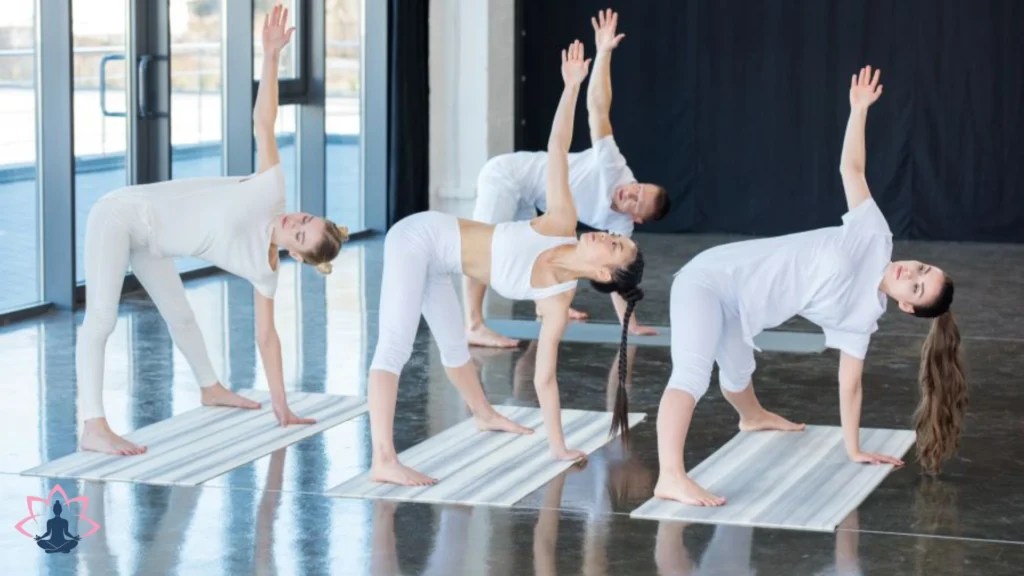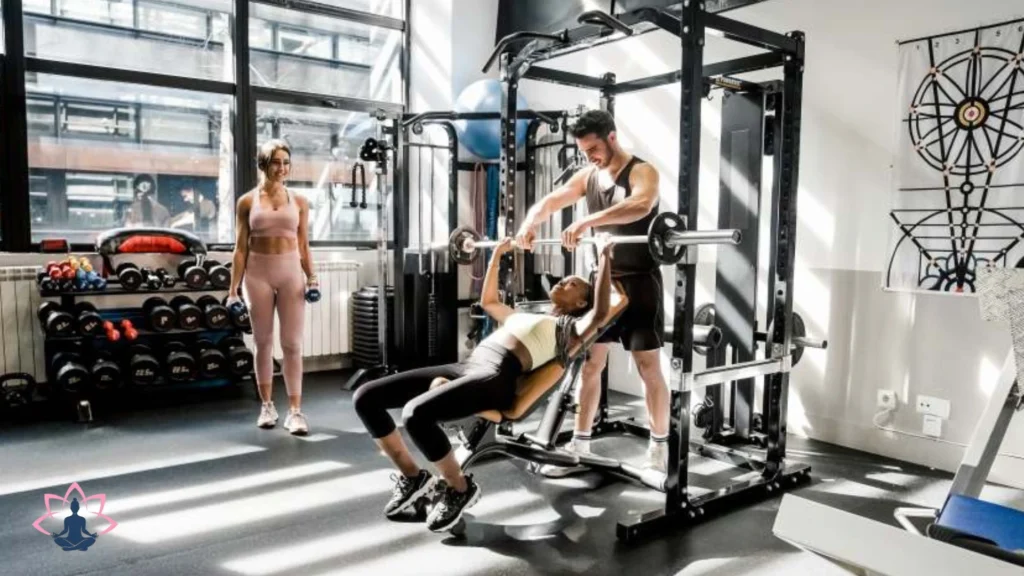Staying fit and healthy is very important for the modern generation. There are many ways to achieve fitness goals, and yoga and gym help in this. However, fitness enthusiasts often get confused when it comes time to choose between yoga and gym. So it is advisable to know about both before making a refined choice.
- What is yoga?
- What is Gym Training?
- Difference between yoga and gym training
- Which Muscles are Involved in Yoga and Gym Training?
- Which is better – yoga or gym training?
- Benefits of Yoga
- Benefits of Gym Training
- Is it safe to engage in both yoga and gym training?
- For a week, how much yoga or gym exercise is appropriate?
- Who should avoid yoga or gym?
- Myths vs. Facts About Yoga
- Myths vs Facts About Gym Training
- FAQs about Gym vs Yoga

When comparing yoga with the gym, are you curious about every detail? This article will give you a comprehensive idea about the comparison between them.
What is yoga?
Yoga is an ancient Indian practice developed by sages. Traditionally, it was used during meditation. Apart from its benefits for physical health, yoga works remarkably on mental health. This type of exercise requires high discipline and constant practice to achieve perfection.
Yoga works by calming the soul and body and awakening spiritual wisdom in individuals. However, practitioners must perform the asanas correctly to get proper results.
What is Gym Training?
Gym training is the process of increasing body strength by performing light to heavy exercises. The main feature of gym training is using different machines and equipment to pump up muscles. So, in these exercises, you need to contract your muscles and apply more force on them.
Gym training is essential for sportspersons, bodybuilders, weightlifters, and powerlifters. It also enhances the positive mental strength of the trainees.
Difference between yoga and gym training
Although both workout regimes aim to build and maintain proper health, they have some different characteristics. If you consider these differences, you will be better able to choose the right option.
| Parameters | Yoga | Gym Training |
| Calorie Burning | Yoga burns calories but slowly. It works more on improving the different organ performances. | Gym training consists of rigid practices which are meant to burn calories prominently. |
| Weight Loss | The contribution of yoga to the weight loss journey is not so noticeable. | Gym training is remarkable for losing weight quickly. |
| Muscle Development | Yoga commonly does not work on muscle development. Hence, a certain type of yoga exercise includes tough practices for better muscles. | Gym training includes exercises with heavy machines, mainly for muscle development. |
| Heart Health | Yoga is definitely a great choice for improving heart health as it is a process of healing from inside. | On the other hand, gym training also works on heart health by burning excess calories, but heavy gym training is not recommended for heart patients. |
| Mental Health | Yoga works brilliantly on mental health. It calms down the anxiety level and boosts positivity. | Gym training mainly gives body strength, though it impacts the freshness of the mind. |
| Diet | You won’t need to follow any strict diet plan for doing yoga until you perform it to cure any disease. | Diet is elementary for gym training. If not followed properly, gym training may not work as it should. |
| Cost-effectiveness | Yoga does not require a lot of money to learn. In fact, you can just watch the poses on YouTube and perform likewise. Thus it is highly cost-effective. | On the other hand, to do gym training, you have to go to the gym and pay an amount to the authority to access all the tools and equipment. |
| Work Process | Yoga works more on the internal organs, muscles and glands and removes toxins. Therefore, it is more effective for detoxification of the body. | Gym training is more about toning muscles and improving cardiovascular performance. However, proper gym training gives the body satisfaction. |
| Equipment Required | Yoga does not require any specific equipment. Having a simple yoga mat is enough. | Gym training requires the use of requipments only available at the gyms. |
| Convenience | Yoga can be done at any time of the day in your house. No specific place or time is required to practise yoga. | For gym training you need equipment only available at your subscribed gym. You cannot do a few exercises without equipment. |
Which Muscles are Involved in Yoga and Gym Training?
Which muscles are involved during training in gym and yoga
Each muscle group plays an important role in yoga and gym workout, although with different importance. The following are some of the primary muscles used in yoga and exercise:

Quadriceps
Yoga postures activate the quadriceps. These muscles are used to stabilize and hold the body in various standing and balancing postures. Exercises like the squat, leg press, and lunge directly target the quads. These movements help strengthen and build the muscles on the front of the thigh.
Hamstrings
Many postures like the forward fold and downward facing dog stretch and engage the hamstrings. Exercises like the deadlift, hamstring curl, and Romanian deadlift directly target the hamstrings. Strengthening the hamstrings is important for overall strength and balance of the legs.
Core muscles
Practically all yoga postures engage the core to some degree for stability and balance. Postures like the plank, boat pose, and various twists specifically target the abdominal muscles. Crunches, planks, Russian twists, and hanging leg lifts are examples of core exercises. These strengthen the abdominal muscles and also improve overall core stability and strength.
Gluteal muscles
Poses such as bridge, warrior, and chair pose activate the glutes to provide stability and strength during hip extension and external rotation. Squats, lunges, hip thrusts, and deadlifts are key exercises to target the gluteal muscles. Lower body strength, hip stability, and posture are all enhanced by strong glutes.
Latissimus dorsi
Poses that involve pulling movements, such as upward-facing dog pose and bow pose, activate the lats to some extent, especially in backbends. Exercises such as pull-ups, lat pulldowns, rows, and deadlifts specifically target the lats. Enhancing posture and upper body strength can be achieved by strengthening the lats.
Deltoid Muscles
Arm balances like crow pose and inverted postures like handstands activate the deltoid muscles for stability and control. Shoulder presses, lateral raises, front raises, and upright rows directly target the deltoid muscles. Strong deltoids contribute to shoulder stability and upper body strength.
Which is better – yoga or gym training?
From the sections mentioned above, you might have a clear idea about yoga and gym. Both of these have beneficial factors for different kinds of body improvements. So, you might need to clarify which one to choose.
In this case, you need to understand your needs first. For example, if you are desperately trying to lose weight, then gym training will be suitable for you.
On the contrary, if you need to focus more on your inner growth, mind power, and better performance of the glands, then you should opt for yoga. Moreover, yoga works slowly but steadily. So you have to give some time to get better results from yoga practice.
Benefits of Yoga

Numerous physical and mental health benefits are provided by yoga. Here are some of the primary benefits:
- Yoga helps in better concentration and happiness of mind
- It is remarkable in reducing stress and anxiety
- Yoga asanas work on the core glands, resulting in more secretion of important hormones and enzymes
- It is extremely helpful for the digestive system
- Yoga builds better immunity, which removes the chances of disease attack
- Doing yoga daily improves the blood circulation system
- Yoga can create perfect balance and flexibility in the body
- It also helps in curing long-term diseases
- It also has anti-aging benefits
Benefits of Gym Training

Gym training offers many benefits that can improve physical, mental, and emotional health. Here are a few of the primary advantages:
- Gym training works on building muscles
- Gym training exercises prepare your muscles to resist stress and exertion
- It is beneficial for healthy weight loss by burning extra calories
- Gym training helps to increase stamina
- Reduces the chances of various medical problems
- Improves blood circulation and activates your cells
- Increases your appetite by working out harder
Is it safe to engage in both yoga and gym training?
The above discussion brings forth the idea of yoga vs gym and proves that they have different results. So, you may wonder if you can do both of them together. So, it is advisable to do yoga and gym together for better results.
Although yoga and gym training are two opposite categories, they can complement each other. Gymming creates stress on the muscles, while yoga relaxes the stress.
Therefore, you can always incorporate yoga into your everyday regimen, regardless of how intense your gym workouts are. Gym training can give you the desired fitness, while yoga can improve inner healing. However, it is recommended that you analyze your stamina, strength, and other abilities before including yoga and gym in your daily exercise regime.
For a week, how much yoga or gym exercise is appropriate?
Depending on your desired result, you can decide how much exercise to do every week. Therefore, yoga hardly has any harmful effects on your body. So, if you do not have any serious health problems, you can do a moderate amount of yoga every day.
As far as gym exercise is concerned, the American College of Sports and Medicine suggests at least 250 minutes of moderate to high intensity weekly workout. So, following this guideline, you cannot workout for more than 40 minutes per day.
So, if you want more prominent muscle growth results, you may have to increase the exercise time further. Therefore, it is recommended that you consult a trainer before choosing any workout regime.
Who should avoid yoga or gym?
Although most people find yoga and gym workouts to be beneficial, depending on their circumstances or health, some people may need to be cautious or avoid these activities completely. Here are some groups of people who should approach yoga or gym workouts with caution or consider alternatives:
1. Recent surgery or injury
Individuals who have undergone or are recovering from an injury or surgery should consult their healthcare provider before starting yoga or gym exercises, as yoga or gym may worsen the condition and cause pain.
2. Severe joint pain or arthritis
People with severe joint pain or arthritis should be cautious of high-impact exercises commonly found in gym workouts. Although it should be done under supervision, yoga can be modified to be easy on the joints.
3. Pregnancy
Pregnant women should practice yoga under a prenatal yoga instructor who can advise safe modifications. Heavy weight lifting or high-impact exercises at the gym should be avoided.
4. Chronic health conditions
People with chronic health conditions such as heart disease, high blood pressure, diabetes or respiratory problems should consult their doctor before starting any new exercise, including yoga or gym workouts.
5. Severe balance issues
People with severe balance issues or dizziness may find some yoga postures challenging or risky. They ought to collaborate with a skilled teacher who can make adjustments and guarantee practice safety.
6. Elderly people
The elderly should exercise caution when exercising at the gym, focusing on low-impact activities that do not put excessive pressure on the joints. Yoga should be modified to account for any balance problems or mobility restrictions.
7. Acute illness or fever
During acute illness or fever, it is advisable to rest rather than engage in strenuous physical activity like gym workouts or vigorous yoga practice. Exercise should be resumed gradually when health improves.
Myths vs. Facts About Yoga
Yoga is a common activity, but its practice can lead to many misconceptions. Here are some widespread misconceptions regarding yoga:
| Myths | Facts |
| Being physically flexible is necessary before starting yoga. | Your body will gradually become more flexible as you learn yoga and continue to practise. |
| There is no need to enrol in a class to learn yoga practices; you can learn them from books. | Learning yoga poses from books is not advisable since one cannot learn the proper form and risks being hurt when practising at home alone. |
| Young folks should practise yoga. Yoga is only for younger people and those who are older aren’t physically capable of doing it. | Yoga instruction is not age-specific. Yoga can never be learned at an older age, but it must be taught by a qualified instructor. |
| Yoga is all about complex postures. Yoga requires bending your body into difficult poses. | Yoga is not just about moving your body in certain ways. Aligning your body, mind, and soul is the main goal of yoga. |
| Yoga is not suitable for overweight people. | People of all shapes and sizes can practise yoga with pose modifications. |
| Yoga sessions are time consuming. | A fast 20-30 minute yoga session is enough to keep you going daily. |
Myths vs Facts About Gym Training
Many people visit the gym daily. However, there are some misconceptions and myths about gym training. Here are some:
| Myths | Facts |
| Longer workouts are more meaningful. | Lifting weights or using the treadmill for extended periods can lead to overuse injuries or muscular strains. |
| Consume more protein and avoid fat and carbs. | Eating too much protein can raise your risk of obesity and heart disease. |
| No pain, no gain. Unless your efforts prove to be painful, you haven’t achieved anything. | Your level of pain or discomfort is not a good indicator of how well you worked out. |
| A good workout Is equal to more sweat. | Sweat is produced in an attempt to control your body’s internal temperature. |
| Weightlifting makes you bulky. | Lifting weights doesn’t produce bodybuilder muscles on its own. |
| Exercise in the morning boosts your metabolism and keeps you fit. | Exercising early in the morning if you’re not a morning person might disrupt your circadian rhythm, making you feel exhausted and lethargic all day. |
So, after this entire discussion, you might have a clear idea of which one to choose between gym and yoga. Hence, when compared, yoga vs gym training also shows the distinct advantages of both. For further clarification, consult an experienced trainer and choose the right trainer by analyzing your body capabilities.
Choosing between yoga and gym workouts mainly depends on personal preferences, fitness goals, and overall health objectives. Yoga offers a holistic approach enhancing flexibility, strength, and mental health through its diverse asanas, pranayama, and meditation practices.
On the other hand, gym workouts focus more on strength training, cardiovascular exercises, and muscle building, which is ideal for individuals aiming to achieve specific fitness goals or athletic performance.
FAQs about Gym vs Yoga
Can yoga be effective on belly fat
Can yoga be effective on belly fat?
coming an amazing version of you. If trimming your waistline and reducing belly fat is part of that, yoga can be a great help.
Is yoga enough for full-body strengthening?
Is yoga enough for full-body strengthening?
The ideas of yoga encompass so much more than the physical practice. Yoga inspires you to practice an overall healthier lifestyle, one focused on beIn a 2016 randomized controlled trial of healthy yet sedentary adults, an 8-week Hatha yoga program was found to be just as effective as a strengthening and stretching exercises to improve functional fitness, with markers including strength as well as: Balance. Flexibility. Mobility.
Is yoga a better workout than the gym?
Is yoga a better workout than the gym?
If you aim rigid weight loss and muscle gain, gym training is ideal. But if you wish to strike a mental and physical balance with inner development, you should choose yoga. However, you will see the results slowly when practicing yoga. To strike the perfect balance, both can be practiced by people who are working.
Yoga or Gym, Which is better for weight loss?
Yoga or Gym, Which is better for weight loss?
If you aim rigid weight loss and muscle gain, gym training is ideal. But if you wish to strike a mental and physical balance with inner development, you should choose yoga. However, you will see the results slowly when practicing yoga. To strike the perfect balance, both can be practiced by people who are working.
Is yoga superior to conventional exercise?
Is yoga superior to conventional exercise?
Yoga also promotes better cognition through specific nostril breathing; this is absent in regular exercise. After yoga, the body experiences relaxation due to the soothing effect on the nervous system. Exercise leads to production of lactic acid, which may cause fatigue and exhaustion.
What is better than a gym?
What is better than a gym?
Exercising at home can be just as effective. While gyms provide dedicated space, home workouts offer more flexibility. Using your time and equipment to maximize efficiency is the key to a great workout. Choose what works best for your lifestyle and fitness goals, says Dr.
Can I use yoga to lose weight?
Can I use yoga to lose weight?
It takes commitment and practice to lose weight through yoga. Yoga helps you to be physically active, burns calories, and may help prevent weight gain.